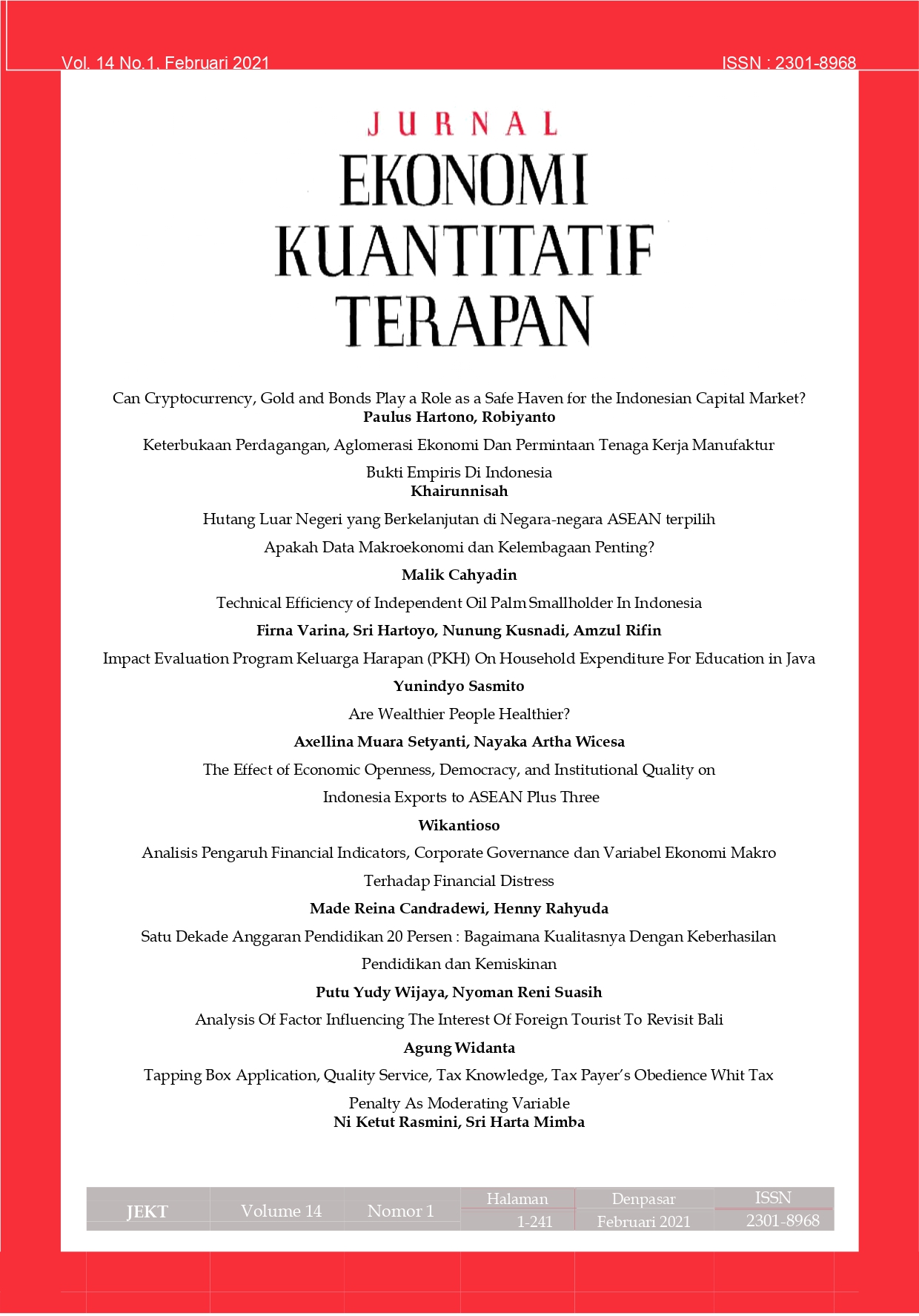One Decade, 20 Percent Education Budget: How About Causality Between Education Success and Poverty?
Abstract
In 2019, exactly one decade of the government expenditure on education in Indonesia (central and local government) was allocated 20 percent. The purpose of this study was to analyze the causality relationship between government budget on education, education success (proxied by the mean years of schooling), and poverty (proxied by the number of poor people) in Indonesia. The data analyzed is secondary data, to be precise panel data from 34 provinces in Indonesia over a period of five years (2015-2019). The analysis technique used is the Granger Causality Test. The results showed that the government budget on education had a significant effect on the mean years of schooling and had a causal relationship with poverty. Meanwhile, poverty has been shown to affect the mean years of schooling. Based on the results of this analysis, it is for the government to consistently prioritize the budget for the education sector because it is proven to have an impact on education success and poverty alleviation. In addition, the government also needs to pursue poverty alleviation programs such as subsidizing cash assistance for student in poverty.
Downloads
References
Sarwar,K., Fatima, H., (2010).
Relationship among education,
poverty and economic growth
in Pakistan: An econometric
analysis. Journal of Elementary
Education, 22(1),23-45.
Arifin, B. dan Murjani, A. 2017.
Pengeluaran Pemerintah Daerah
pada Sektor Pendidikan,
Kesehatan dan Kemiskinan
Terhadap Indeks Pembangunan
Manusia (Studi pada
Kabupaten/Kota di Provinsi
Kalimantan Selatan). Jurnal
Transformasi Administrasi, 07(02),
1352-1368.
Bado, B. dan Hasbiah, S. 2017. Analisis
Pertumbuhan Belanja Sektor
Pendidikan Terhadap Capaian
Rata-rata Lama Sekolah di
Sulawesi Selatan. Jurnal
Economix, 5(1), 238-249.
Batubara, Dison M.H dan Saskara, I.A.
Nyoman, 2015. Analisis
Hubungan Ekspor, Impor, PDB
dan Utang Luar Negeri
Indonesia Periode 1970-2013.
Jurnal Ekonomi Kuantitatif
Terapan Vol 8, No 1 Februari Pp
46-55
Boediono, 1999. Teori Pertumbuhan
Ekonomi. Yogyakarta: BPFE
UGM
Faturochman dan Ambar
Widaningrum. (2011).
Pendidikan untuk kaum kecil.
Research center of population.
UGM.
Fauzi, M., 2007 Metode Penelitian
Kuantitatif, Semarang:
Walisongo Press.
Gupta, S., Hamid Davoodi and Rosa
Alonso-Terme, 2002. Does
corruption affect income
inequality and poverty?
Economics of Governance, vol. 3,
issue 1, Pp 23-45
Ilhami, Syahril. 2014. Analisis Pengaruh
Anggaran Pendidikan Terhadap
Indeks Pembangunan Manusia
Di Indonesia. Tesis. Sekolah
Pasca Sarjana. Institut Pertanian
Bogor. Bogor.
Izzaty. 2009. Faktor-faktor yang
mempengaruhi partisipasi
sekolah anak jenjang SMP dan
SMA di Sumatera Barat. Jurnal
Jhingan, M. L. 1992. Ekonomi
Pembangunan dan Perencanaan.
Rajawali, Jakarta.
Knight, John.,Li Shi dan Deng Quheng,
2008. Education and the Poverty
Trap in Rural China. CSAE
Working Paper Series 2008-02,
Centre for the Study of African
Economies, University of
Oxford.
Kamsol, Maryunani, Susilo, Gozali.
2014. Analysis of Education
Financial Restructuring
Strategies to Increase Human
Resource Quality in Riau
Province. IOSR Journal of
Economics and Finance, 2(4), 45-
55.
Nandani, S. C. D., Setyadin, B.,
Nurabadi, A. 2018. Analisis
Alokasi Anggaran Pendidikan
Dalam Anggaran Pendapatan
Belanja Daerah. Jurnal
Administrasi dan Manajemen
Pendidikan, 1(1), 22-28.
Nurkholis. 2013. Pendidikan dalam
Upaya Memajukan Teknologi.
Jurnal Kependidikan, 1(1), 24-44.
Rony, M. 2016. Analisis Determinan
Rata-rata Lama Sekolah
Kabupaten/Kota di Propinsi
Kalimantan Barat Tahun 2009-
2015. Jurnal Curvanomic, 5(4).
Samirin, Wijayanto. (2014). Mengurangi
ketimpangan, meluruskan
esensi pembangunan. Presented
in scientific papers, in order to
anniversary -16, Paramadina
University, Jakarta, 10 January
2014.
Schultz, Theodore W., 1961. Investment
in Human Capital. The American
Economic Review. 51 (1): 1–17.
JSTOR 1818907.
Sesmiati. 2009. Faktor – Faktor yang
Mempengaruhi Drop Out di
Kenagarian Batu Plano
Kecamatan Sungai Pua,
Kabupaten Agam. Skripsi. UNP
Suasih, NNR., Wijaya, P.Y., Kawiana,
IGP., Saskara, IAN., 2020.
Causality Analysis Between
Education and Poverty in
Indonesia as an Effort to
Achieve SDGs:: Technium
Conference 4, 30.05.
Suparmoko, 1987. Metode Penelitian
Praktis (untuk ilmu-ilmu sosial
dan ekonomi). Yogyakarta:
BPFE
Todaro, M. dan Smith, S. 2004.
Pembangunan Ekonomi di Dunia
Ketiga. Edisi kedelapan. Jakarta :
Erlangga.
Todaro, Michael P. 2000. Pembangunan
Ekonomi di Dunia Ketiga.
Erlangga. Jakarta.
Widyastuti, A. (2012). Analisis
hubungan antara produktivitas
pekerja dan tingkat pendidikan
pekerja terhadap kesejahteraan
keluarga di Jawa Tengah Tahun
2009. Vol. 1 No. 1. pp.1-11.




















